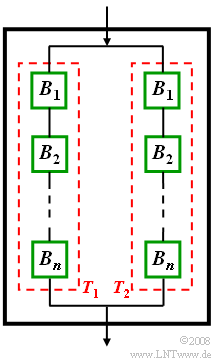Difference between revisions of "Aufgaben:Exercise 1.5Z: Probabilities of Default"
| Line 2: | Line 2: | ||
{{quiz-Header|Buchseite=Theory_of_Stochastic_Signals/Statistical_Dependence_and_Independence}} | {{quiz-Header|Buchseite=Theory_of_Stochastic_Signals/Statistical_Dependence_and_Independence}} | ||
| − | [[File:P_ID87__Sto_Z_1_5.png|right|frame|Functional circuit diagram of a device]] | + | [[File:P_ID87__Sto_Z_1_5.png|right|frame|Functional circuit diagram of a device with two identical parts $T_1$ and $T_2$ ]] |
| − | A device part is composed of the components $B_1, \ B_2,\ \text{...} \ , B_n$ where the respective functionality can be assumed to be independent of all other components. | + | A device part is composed of the components (German: "Bauteile" ⇒ "B") $B_1, \ B_2,\ \text{...} \ , B_n$ where the respective functionality can be assumed to be independent of all other components. |
| − | *Assume that all components default with equal probability $p_{\rm A}$ | + | *Assume that all components default with equal probability $p_{\rm A}$. |
| − | *Part $T_1$ functions only if all $n$ components are functional. | + | *Part (German: "Teilgerät" ⇒ "T") $T_1$ functions only if all $n$ components are functional. |
| − | To increase reliability, important assemblies are often duplicated. The device $G$ can | + | To increase reliability, important assemblies are often duplicated. The device (German: "Gesamtgerät" ⇒ "G") $G$ can be described in terms of set theory as follows: |
:$$ G = T_1 \cup T_2.$$ | :$$ G = T_1 \cup T_2.$$ | ||
This means: Device $G$ is already operational if at least one of the two identical subassemblies $(T_1$ or $T_2)$ is functional. | This means: Device $G$ is already operational if at least one of the two identical subassemblies $(T_1$ or $T_2)$ is functional. | ||
| − | |||
| − | |||
| Line 25: | Line 23: | ||
*The topic of this chapter is illustrated with examples in the (German language) learning video | *The topic of this chapter is illustrated with examples in the (German language) learning video | ||
| − | :[[Statistische_Abhängigkeit_und_Unabhängigkeit_(Lernvideo)|Statistische Abhängigkeit und Unabhängigkeit]] $\Rightarrow$ "Statistical dependence and independence". | + | ::[[Statistische_Abhängigkeit_und_Unabhängigkeit_(Lernvideo)|Statistische Abhängigkeit und Unabhängigkeit]] $\Rightarrow$ "Statistical dependence and independence". |
| Line 35: | Line 33: | ||
$p_\text{T, max} \ = \ $ { 2 3% } $ \ \%$ | $p_\text{T, max} \ = \ $ { 2 3% } $ \ \%$ | ||
| − | {Let the default probability of all components be $\underline{p_{\rm | + | {Let the default probability of all components be $\underline{p_{\rm B} = 0.1}$. Let each subdevice consist of $n = 3$ components. <br>Calculate the probability $p_{\rm T}$ exactly that a subdevice defaults. |
|type="{}"} | |type="{}"} | ||
$p_{\rm T} \ = \ $ { 27.1 3% } $ \ \%$ | $p_{\rm T} \ = \ $ { 27.1 3% } $ \ \%$ | ||
| − | {What value is obtained for $\underline{p_{\rm | + | {What value is obtained for $\underline{p_{\rm B} = 0.01}$? In what form can you approximate $p_{\rm T}$ for small values of $p_{\rm B}$ ? |
|type="{}"} | |type="{}"} | ||
$p_{\rm T} \ = \ $ { 2.97 3% } $ \ \%$ | $p_{\rm T} \ = \ $ { 2.97 3% } $ \ \%$ | ||
| − | {Now apply $p_{\rm | + | {Now apply $p_{\rm B} = 0.4\%$ for the default probability of all components. What is the maximum number of components the subdevice can contain? $p_{\rm T} ≤ 2\%$ is to hold. |
|type="{}"} | |type="{}"} | ||
$n \ = \ $ { 5 3% } | $n \ = \ $ { 5 3% } | ||
Revision as of 16:56, 30 November 2021
A device part is composed of the components (German: "Bauteile" ⇒ "B") $B_1, \ B_2,\ \text{...} \ , B_n$ where the respective functionality can be assumed to be independent of all other components.
- Assume that all components default with equal probability $p_{\rm A}$.
- Part (German: "Teilgerät" ⇒ "T") $T_1$ functions only if all $n$ components are functional.
To increase reliability, important assemblies are often duplicated. The device (German: "Gesamtgerät" ⇒ "G") $G$ can be described in terms of set theory as follows:
- $$ G = T_1 \cup T_2.$$
This means: Device $G$ is already operational if at least one of the two identical subassemblies $(T_1$ or $T_2)$ is functional.
Hints:
- The exercise belongs to the chapter Statistical dependence and independence.
- The topic of this chapter is illustrated with examples in the (German language) learning video
- Statistische Abhängigkeit und Unabhängigkeit $\Rightarrow$ "Statistical dependence and independence".
Questions
Solution
- $$\rm Pr(\it G \rm \hspace{0.1cm}f\ddot{a}llt\hspace{0.1cm}aus) = Pr(\it T_{\rm 1}\rm \hspace{0.1cm} f\ddot{a}llt \hspace{0.1cm}aus) \cdot Pr(\it T_{\rm 2}\rm \hspace{0.1cm} f\ddot{a}llt \hspace{0.1cm}aus). $$
- Moreover, since subdevices $T_1$ and $T_2$ are identical in construction, they default with the same probability $p_{\rm T}$ . It follows that:
- $$p_{\rm G} = \it p_{\rm T}^{\rm 2} \hspace{0.5cm} \rm bzw. \hspace{0.5cm} \rm \it p_{\rm T,\hspace{0.1cm}max}= \sqrt{\it p_{\rm G}} \le \rm\sqrt{0.0004} \hspace{0.15cm}\underline {= 2\%}.$$
(2) This result is easier to determine using the complementary event:
- $$\rm Pr(\it T_{\rm 1}\hspace{0.1cm}\rm functions) = \rm Pr(\it B_{\rm 1} \hspace{0.1cm}\rm functions \cap \it B_{\rm 2} \hspace{0.1cm} \rm functions \cap \it B_{\rm 3}\hspace{0.1cm} \rm functions).$$
- $$\Rightarrow 1- p_{\rm T}= (1-p_{\rm A})^{3} \hspace{0.3cm} \Rightarrow \hspace{0.3cm} 1-p_{\rm T}=(0.9)^3= 0.729 \hspace{0.3cm} \Rightarrow \hspace{0.3cm} p_{\rm T}\hspace{0.15cm}\underline {= 0.271 = 27.1\%}.$$
(3) With $p_{\rm A} = 0.01$ , we obtain $p_{\rm T}\hspace{0.15cm}\underline {= 2.97\%}.$
- In general, the approximation is: $p_{\rm T} \approx n \cdot p_{\rm A}\; (= 3\%)$.
(4) With the approximation of the last subtaks $\underline{n = 5}$ follows directly.
- For larger $p_{\rm A}$ , one would have to proceed as follows:
- $$0.996^{\it n}\ge 0.98 \hspace{0.5cm} \rm\Rightarrow \hspace{0.5cm} \it n\le\rm\frac{log(0.98)}{log(0.996)} = 5.0406\hspace{0.15cm}\underline { \approx 5}.$$
